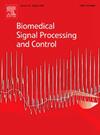A new algorithm for removing random motion noise of human body based on total variation
IF 4.9
2区 医学
Q1 ENGINEERING, BIOMEDICAL
引用次数: 0
Abstract
Millimeter-wave radar sensors have garnered significant attention in non-contact monitoring for detecting human vital signs, particularly respiration and heart rate. These sensors offer advantages such as compact size, lightweight design, and versatility in sensing across diverse scenarios. Among them, frequency-modulated continuous wave (FMCW) radar demonstrates considerable potential for vital sign monitoring. However, a critical challenge persists, human random motion noise, which spans the entire frequency domain, significantly interferes with accurate heartbeat signal detection. To address this issue, this paper proposes a total variation model-based approach. This method involves reconstructing the thoracic signal matrix, converting it into a grayscale image, and obtaining the sparse characteristics of noise and the underlying image structure based on the second-order gradient information in different directions of the image. By introducing the Lp pseudo-norm, the second-order regularization constraint terms in the horizontal and vertical directions are designed respectively. Meanwhile, a global sparse constraint term was designed based on the prior characteristics of the noise. Then, the noise and the sparse characteristics of the underlying image structure are utilized for denoising, and finally, the thoracic cavity signal is reverse-reconstructed. This framework effectively suppresses random body motion noise while preserving vital sign information. Experimental results demonstrate a notable improvement in signal-to-noise ratio (SNR), along with enhanced measurement accuracy for both respiratory rate and heart rate. The findings of this study not only advance the theoretical framework for non-contact vital sign monitoring but also underscore the practical utility of FMCW radar in real-world applications.

基于全变分的人体随机运动噪声去除新算法
毫米波雷达传感器在非接触式监测人类生命体征,特别是呼吸和心率方面得到了极大的关注。这些传感器具有尺寸紧凑、设计轻便、多功能性等优点,可用于各种场景的传感。其中,调频连续波(FMCW)雷达在生命体征监测方面显示出相当大的潜力。然而,一个关键的挑战仍然存在,人类随机运动噪声跨越整个频域,严重干扰准确的心跳信号检测。为了解决这一问题,本文提出了一种基于总变分模型的方法。该方法对胸椎信号矩阵进行重构,将其转换为灰度图像,并根据图像不同方向的二阶梯度信息获得噪声的稀疏特征和底层图像结构。通过引入Lp伪范数,分别设计了水平方向和垂直方向的二阶正则化约束项。同时,根据噪声的先验特征设计了全局稀疏约束项。然后利用底层图像结构的噪声和稀疏特性进行去噪,最后对胸腔信号进行反向重构。该框架有效地抑制了随机体运动噪声,同时保留了生命体征信息。实验结果表明,在信噪比(SNR)显著改善的同时,提高了呼吸频率和心率的测量精度。本研究结果不仅为非接触式生命体征监测提供了理论框架,而且强调了FMCW雷达在实际应用中的实际应用价值。
本文章由计算机程序翻译,如有差异,请以英文原文为准。
求助全文
约1分钟内获得全文
求助全文
来源期刊

Biomedical Signal Processing and Control
工程技术-工程:生物医学
CiteScore
9.80
自引率
13.70%
发文量
822
审稿时长
4 months
期刊介绍:
Biomedical Signal Processing and Control aims to provide a cross-disciplinary international forum for the interchange of information on research in the measurement and analysis of signals and images in clinical medicine and the biological sciences. Emphasis is placed on contributions dealing with the practical, applications-led research on the use of methods and devices in clinical diagnosis, patient monitoring and management.
Biomedical Signal Processing and Control reflects the main areas in which these methods are being used and developed at the interface of both engineering and clinical science. The scope of the journal is defined to include relevant review papers, technical notes, short communications and letters. Tutorial papers and special issues will also be published.
 求助内容:
求助内容: 应助结果提醒方式:
应助结果提醒方式:


